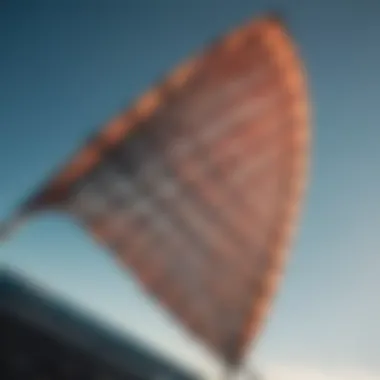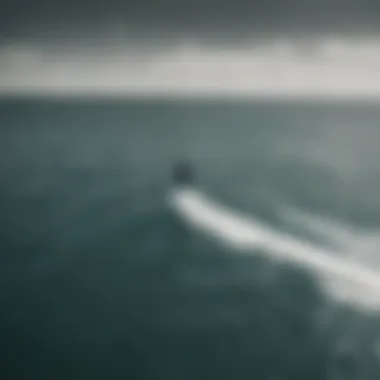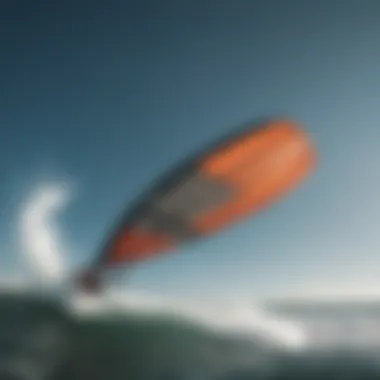Exploring Duotone Wings in Kiteboarding


Intro
Kiteboarding has taken the watersports scene by storm, combining elements of surfing and paragliding into a thrilling experience. Among the integral elements of kiteboarding are duotone wings, which have become increasingly popular due to their unique design and performance attributes. Stretching beyond mere function, these wings bring an aesthetic flair that captivates both newbies and veterans alike. This exploration will unfold the intricate dynamics of duotone wings, focusing on their aerodynamics and design aesthetics while shedding light on user experiences and changing trends.
Gear Insights
When it comes to kiteboarding gear, duotone wings are not just another piece of equipment; they are a game changer. The advancement in design and technology surrounding these wings has given kiteboarders a versatile tool that enhances their performance on various water surfaces.
Latest Gear Reviews
The latest duotone wings on the market reveal fascinating innovations:
- Duotone Echo: This model is designed for riders looking for an all-around wing that delivers good speed and stability. Its canopy material exhibits superb strength while being lightweight, making it a solid choice for both tricksters and straightforward cruisers.
- Duotone Wing Style: This one stands out for its excellent handling. The wing design is optimized for a balance between lift and control, perfect for those advanced maneuvers.
Many reviews point out that these wings don’t just soar; they provide a seamless riding experience and can withstand variable wind conditions, contrasting strongly against older models.
Essential Gear for Beginners
For newcomers venturing into kiteboarding, selecting the right duotone wing can significantly impact their learning curve. Here are key aspects to consider:
- Size Matters: Beginners should start with a larger wing as it allows for easier lift and control, reducing the chances of wipeouts.
- Stability Features: Look for wings that have added stability features to aid in learning.
- User-Friendly Design: A wing that offers an intuitive feel will make the experience that much more enjoyable.
Investing in gear from the beginning can make a world of difference, and the right duotone wing can be the companion that nurtures skill development.
Techniques and Tips
Understanding the equipment is only half the battle. Kiteboarders must also feel comfortable with the techniques and safety measures associated with using duotone wings.
Advanced Tricks and Techniques
Once you're past the beginner stage, harnessing the full potential of duotone wings can lift your kiteboarding game to new heights. Here are some advanced techniques to explore:
- Jumping: By pulling down on the backhand while steering quickly in the desired direction, riders can maximize lift and clearance from the water.
- Downwind Speed Runs: To harness maximum speed, angle the wing away from direct wind while keeping a smooth stance and strong core.
- Tacking and Jibing: Mastering these techniques will allow for efficient redirects and smoother transitions.
Exploring these tricks helps riders become more dynamic and fluid on the water, enhancing the overall experience.
Safety Practices for Kiteboarders
Safety is paramount in any adventure sport. Here are some essential practices:
- Pre-Flight Checks: Always inspect your gear before heading out. Ensure lines are untangled and equipment is in working order.
- Understand Weather Conditions: Knowledge of wind patterns and changes can greatly reduce risks. Extreme winds can turn a great day into a perilous adventure.
- Wear Safety Gear: Investing in protective gear, such as impact vests and helmets, is not just wise but can make a substantial difference if accidents occur.
"Safety first, fun can always follow. Know your limits and push the envelope wisely."
As kiteboarding with duotone wings becomes a more aligned experience, riders are encouraged to draw on both the aesthetic design and aerodynamic capabilities to truly enhance their adventures. The more one grasps these principles, the greater the enjoyment and mastery of the sport will become.
Preface to Duotone Wings
In the ever-evolving landscape of kiteboarding, duotone wings have carved out a significant niche, bringing together the thrill of aerial maneuverability with the elegance of design. Understanding the essence of duotone wings is crucial for both novice and seasoned kiteboarders who seek to elevate their performance. These wings, distinct in their construction and visual appeal, boast a combination of aerodynamic efficiency and aesthetic charm that continues to captivate the kiteboarding community.
The importance of this topic extends beyond mere functionality; it’s about embracing a new era of kiteboarding gear that emphasizes not only how a kite performs but also how it influences the experience of riding. Recognizing the specific elements—like shape, materials, and functionality—allows riders to make informed choices that can enhance their skill level and enjoyment.
Moreover, considerations surrounding these wings delve into the benefits they offer. From accelerating a rider’s learning curve to enhancing stability and control in various wind conditions, duotone wings present myriad advantages. Their design reflects a blend of art and science, creating not just a tool for riding, but a statement piece that embodies the spirit of adventure.
Defining Duotone Wings


Duotone wings refer to a modern style of inflatable wings used in kiteboarding. Distinguished primarily by their dual color schemes, these wings are designed to provide an excellent combination of lift, stability, and handling. Typically, they are produced with lightweight, durable materials that allow for quick inflation and deflation, making them user-friendly and accessible.
These wings operate on the principles of lift and drag, generating a significant amount of lift with minimal resistance. Unlike traditional kites, which rely heavily on a bridle system, duotone wings often feature a strutless design that enhances the rider’s direct connection with the wind, allowing for finer control.
Many riders appreciate the adaptability that duotone wings offer. Whether used in flat water, choppy conditions, or with varying wind speeds, these wings can perform exceptionally, allowing riders to tackle diverse environments effectively.
Historical Evolution of Wing Design
The evolution of wing design in kiteboarding reflects the sport's growth and innovation. Traditionally, single-skin inflatable kites dominated the scene, providing riders with sufficient lift but limited dexterity. The genesis of duotone wings emerged from the need for a more versatile, streamlined, and responsive design.
In the early 2000s, advancements in material technology began paving the way for more sophisticated designs. Riders experimented with various shapes and sizes, seeking a balance that favored control and speed. This period saw the introduction of wings that allowed for more defined maneuverability and ease of use, leading to hybrids that combined the best of both traditional kites and surf wings.
Today, the culmination of years of design evolution is represented in duotone wings, which showcase not only refined aerodynamics but also class-leading performance characteristics. The aesthetic aspects have also progressed alongside functionality, allowing for personal expression through diverse color palettes and customizable options. While the fundamentals of wing design remain rooted in physics, the artistry involved in creating visually stunning and high-performing wings signals a new chapter in the sport's legacy.
Understanding Aerodynamics in Kiteboarding
Grasping the principles of aerodynamics is paramount in kiteboarding for multiple reasons. This understanding enables kiteboarders to not only enhance their performance but also maximize the enjoyment of their ride. It's akin to having the right map when navigating through unknown waters—knowing where the winds blow and how they interact with your gear can spell the difference between a mediocre outing and an exhilarating experience.
A key aspect here is the relationship between the kite and the wind. Movement through the air creates forces that influence the kite's performance. Kiteboarding, fundamentally, is about harnessing these forces—maneuvering your wing in such a way as to capture the wind, generating lift to elevate and glide across water.
Fundamentals of Aerodynamics
The basics of aerodynamics boil down to two primary principles: lift and drag. Lift is what enables a kite to rise, while drag opposes motion, working against the speed you can achieve. In kiteboarding, the design and shape of the wings—especially the duotone wings—play a crucial role in optimizing these forces.
- Lift: For a kite to achieve lift, its surface area, angle relative to the wind, and speed must be finely tuned. Wings designed with specific profiles can generate more lift with less effort, allowing users to soar effortlessly.
- Drag: This is an opponent to speed. Understanding drag can help riders adjust their technique and wing positioning, effectively lowering resistance. A wing that slices through the air more cleanly creates a smoother ride—ideal for those looking to push their limits.
Furthermore, aspects like Aspect Ratio are key. The term refers to the ratio of the wing's width to its height. A higher aspect ratio typically means less drag and more lift at speed, which is why many kiteboarders gravitate towards duotone wings. They are designed with this ratio in mind to maximize performance across various conditions.
How Duotone Wings Leverage Aerodynamic Principles
Diving into how duotone wings optimize these aerodynamic principles reveals a fascinating interplay of design and performance. First off, the camber in the wing’s structure—this is the curvature of the wing—helps in generating lift. By altering the camber, designers can change how the wing interacts with the wind.
Duotone wings also utilize innovative materials that enhance weight distribution. This means that they can have a larger surface area while maintaining lightness—an essential characteristic when you’re gliding across turbulent waters.
- Foil design: The wings often feature a double surface, which boosts airflow and enhances the overall lift. Riders subsequently notice improved stability, especially on those blustery days.
- Wing shape: Duotone wings have a reflex profile, meaning they tend to stabilize on their own, reducing the need for constant input from the pilot. This lets the rider focus more on enjoying the ride rather than making constant adjustments.
Overall, understanding the aerodynamics behind duotone wings not only provides riders with a technical perspective but also empowers them to make informed choices when selecting their equipment. The confluence of lift generation, drag reduction, and responsive designs makes these wings a practical and advantageous choice in the ever-evolving landscape of kiteboarding.
"Capturing the wind effectively can transform your entire kiteboarding experience, allowing exploration of previously unreachable terrains."
In summary, the intricacies of aerodynamics within kiteboarding are not just academic. They have real implications for the performance of duotone wings, leading to increased satisfaction and skill development for all kiteboarding enthusiasts.
Material Aspects of Duotone Wings
The material aspects of duotone wings play a crucial role in defining both their performance and longevity. Each element helps shape the overall experience a kiteboarder has on the water. As kiteboarding continues to evolve, so too does the importance placed on the materials used in wing construction. They can significantly influence not only aerodynamics but also how the wing interacts with environmental factors such as wind and water.
Fabric Choices and Their Implications
When diving into fabric choices, it's essential to understand that different materials carry distinct properties. For instance, wings commonly use ripstop nylon or polyester. Ripstop nylon, known for its durability and lightweight nature, offers better tear resistance. This is particularly vital when out in choppy waters where the risk of snagging is higher. On the other hand, polyester, often more affordable, brings decent strength but may not withstand as much wear and tear.
- Ripstop Nylon: Well-suited for performance and durability, this material can handle the rigors of extensive use. The risk of tears is minimized, making it a popular pick.
- Polyester Fabric: Generally heavier and less durable, but could suit beginner kiteboarders or casual riders who don't require high-performance gear.
- Hybrid Materials: Some manufacturers are using innovative blends which offer a balance between weight and strength, ideal for riders looking for all-around options.
Understanding the implications of fabric choice helps kiteboarders align their wings with their riding style and conditions. For instance, a competitive kiteboarder might favor premium ripstop nylon for performance, while a casual enthusiast might prioritize cost-effectiveness with polyesters.
Impact Resistance and Durability
Another key consideration is impact resistance and durability. Kiteboarding isn't all smooth sailing. A sudden gust can throw a rider off, and impacts can occur from collisions, rough landings, or unanticipated elements in the water. It's where the resilience of materials becomes apparent.


- Pre-Reinforcement Technologies: Some wings feature technologies designed to enhance impact resistance. By reinforcing key stress points, manufacturers ensure that the wings can endure strikes without compromising performance.
- Seams and Stitching: The construction of seams also holds importance. Not all stitching methods are created equal. Double-stitched seams generally provide better durability than single stitching. This is paramount for the longevity of the wing.
- Maintenance Considerations: Kiteboarding enthusiasts should also consider that proper maintenance can bolster durability. Rinsing the wings after use and storing them in a cool, dry place helps prevent material degradation over time.
"Choosing the right material is just as important as mastering the techniques in kiteboarding. A good wing can transform your ride from average to exhilarating." - Expert Kiteboarder
Performance Characteristics
When it comes to kiteboarding, the thrill is not just in the ride but also in the characteristics that define performance. In this section, we dive into the performance characteristics of duotone wings, examining how these elements shape the overall kiteboarding experience. Speed, handling, lift, and stability are all essential components that can make or break a session on the water. The nuances in design and craftsmanship can greatly influence these factors, providing riders with both challenges and enhancements to their ride.
Speed and Handling Efficiency
Speed is often the first thing that draws kiteboarders to certain wings. Duotone wings are crafted using innovative design techniques that foster speed without sacrificing control. When you’re soaring over the waves, that feeling of acceleration is exhilarating. The well-engineered canopy shape helps in this sense. A flatter profile can allow the rider to cut through the air with greater ease, while a deeper, more concave design can generate lift and enhance stability at higher velocities.
Efficient wing handling makes a difference as well. Imagine a wing that feels like an extension of your body—responsive and intuitively reacting to your every move. This kind of agility can be attributed to careful weight distribution and the choice of materials that balance flexibility with rigidity. Riders often highlight the importance of learning how the wing responds in various winds; understanding this can take your performance up a notch.
- Key Benefits of Speed and Handling Efficiency:
- Better acceleration means quicker starts from still water.
- Improved control assists in tricky maneuvers, especially in choppy conditions.
- A well-handled wing provides increased confidence, leading to longer sessions and more complex tricks.
Lift and Stability in Various Conditions
Lift and stability may seem like technical jargon, but these concepts are the bread and butter of a successful kiteboarding session. Lift is essential for getting airborne—whether you’re executing smooth jumps or just maintaining your ride in challenging conditions. Duotone wings are designed with features that enhance lift potential, allowing riders to feel buoyant even when the wind isn’t in their favor.
However, lift alone doesn't do the trick. Stability plays a significant role in ensuring that a rider doesn’t get tossed around like a ragdoll in turbulent gusts. Well-crafted wings can maintain composure during sudden shifts in wind or changes in terrain. Riders consistently appreciate duotone wings for their ability to offer a stable flight path, minimizing unwanted dips or erratic movements.
"A stable ride is the foundation upon which all great performances are built, allowing for creativity and freedom on the water."
- Factors Influencing Lift and Stability:
- Wing shape and surface area directly correlate to lift capacity—larger surface means more lift.
- Aspect ratio impacts how the wing interacts with the wind, balancing speed with maneuverability.
- Quality of materials determines how well the wing stands up under stress, affecting both lift and stability.
In essence, perfecting performance characteristics contributes to an unmatched kiteboarding experience. Duotone wings exemplify a harmonious blend between speed, handling, lift, and stability. For those looking to refine their skills and elevate their time on the water, understanding these aspects is paramount.
User Experience and Feedback
User experience and feedback are crucial in understanding the overall effectiveness of duotone wings in kiteboarding. These insights stem from the real-world interactions of kiteboarders with these wings, offering practical perspectives that technical specifications alone may not convey. By gauging the sentiments of users, manufacturers can adjust designs, improve performance, and cater closely to the needs of the kiteboarding community.
The experience of using a duotone wing goes beyond its technical features. It embodies the feelings of excitement, freedom, and the rush that comes with riding the waves. This makes the feedback from users particularly valuable; it provides an angle on usability and comfort that is often overlooked. A kiteboarder may rave about maneuverability, but another might express concerns over weight distribution or balance.
Key elements to consider include:
- Ease of Use: How intuitive is it for both beginners and seasoned kiteboarders?
- Comfort Level: Do users feel secure, or do they struggle with the wing’s handling during adverse conditions?
- Versatility: Can it perform well across different wind conditions, or is it limited?
- Aesthetic Appeal: Do the colors and design resonate with the rider’s personal taste?
- Durability: How well does the wing hold up against wear and tear?
Understanding these facets elevates the kiteboarding experience and helps build a community bound by shared knowledge.
Comparative Analysis with Traditional Wings
When we stack duotone wings against traditional wings, the differences start to stand out. Traditional wings often rely on more conventional designs that can limit performance in specific scenarios. For instance, users frequently comment on how duotone wings provide a better lift-to-drag ratio. Riders note that they can glide more smoothly, which translates to longer rides and less fatigue.
Another common point of discussion revolves around control. With traditional wings, experienced users might find themselves overcompensating for shifts in wind direction, leading to erratic movements. In contrast, duotone wings, with their modern design, give riders a greater sense of stability. This could lead to a more enjoyable ride, particularly for those who are still honing their skills.
Furthermore, the ease with which one can adjust settings on duotone wings adds to their appeal. From changing the wing’s aspect ratio to fine-tuning the tension, users appreciate the fine-natured adjustments that meet their unique riding styles. In essence, embracing duotone wings often results in a more tailored experience, something traditional wings may lack.
Community Insights and Recommendations
The community's feedback regarding duotone wings is a rich tapestry of insights and recommendations that often reflect a collective wisdom acquired through years of experience. Forums, such as those on Reddit, show a lively exchange where kiteboarders share their encounters with both duotone and traditional wings.
From what is discussed:


- Flexibility in Design: Riders urge newcomers to experiment with color schemes that resonate with their style, feeling that personalization can enhance the connection with their gear.
- Recommended Sizes: Many participants suggest sizing up for beginners to allow more margin for error, highlighting that even small adjustments in wing size can drastically impact control and comfort.
- Maintenance Tips: Users frequently share advice on wing care, from regular cleaning to the best way to store them to avoid wear. They emphasize that a well-maintained wing lasts longer and performs better.
- Learning from Each Other: Experienced riders are always willing to mentor newbies, and community events often provide spaces where knowledge transfer occurs naturally.
In sum, the community acts as a support network, with each member's experiences contributing to a greater understanding of the duotone wing's capabilities and intricacies. This directly shapes the recommendations shared through word of mouth or online platforms, allowing for ongoing growth in the sport.
Aesthetic Considerations
The visual appeal of duotone wings goes beyond the surface; it intertwines with user performance and personal expression. Kiteboarding isn’t just about the rush of adrenaline or mastering the waves; it's also about showcasing one's style. Aesthetic considerations in duotone wings serve as a bridge between personal identity and physical performance, making them significant not just for the look but as a component of the overall kiteboarding experience.
The intersection of color schemes, design elements, and how these choices resonate with users shapes the way kiteboarders perceive their gear. In this fast-paced sport, visuals can often influence decisions when selecting equipment. As many enthusiasts would say, a kite is not just a tool; it’s an extension of who they are on the water.
Color Schemes and Customization Options
Color schemes play a pivotal role in not only enhancing visibility on the water but also in how users connect with their wings. The choices available range from vibrant hues that catch the eye from afar to more discreet tones that blend into the environment.
Customization options for duotone wings allow riders to select patterns and colors that mirror their personality.
- Visibility: Bright colors improve safety by enhancing visibility in varying conditions. For example, a striking neon yellow against the azure sea stands out, making it easier for others to spot the rider.
- Personalization: Many brands promote options for personalized graphics, letting users showcase unique designs catering to individual tastes. This means no two wings need to look alike.
- Trends and fads: Color preferences may shift with trends, leading manufacturers to release seasonal palettes. Keeping an eye on current styles in the kiteboarding community can inspire fresh looks.
These choices do more than merely satisfy aesthetic needs; they also contribute to a kiteboarder's signal to others about their identity and preferences within the larger kiteboarding culture.
Impact of Design on User Preference
The design elements of duotone wings extend beyond the aesthetic and have practical implications too. A good design considers functionality, enhancing rider comfort and confidence. The usability of a wing often factors into how appealing it is to the rider. Elements worth considering include:
- Streamlined Profiles: Sleeker designs usually correlate with enhanced performance. Riders often find themselves drawn to wings that not only look good but also perform optimally in the air.
- User Comfort: An aesthetically pleasing wing is also one that does not compromise comfort in its structure. Padding placements, texture, and finish contribute to how pleasant the experience is while riding.
- Brand Identity: Sometimes, the design of a duotone wing reflects the ethos of the brand. Users may be naturally inclined to prefer wings from brands that resonate with their values and aspirations, whether it be sustainability in materials or innovation in technology.
"The right wing can not only elevate your kiteboarding game but also make you look stylish while doing it."
Ultimately, the aesthetics of duotone wings meld with their practical features, forging a connection between riders and their equipment. As kiteboarding grows in popularity, the understanding of how aesthetics influence preferences becomes ever crucial for both manufacturers and users alike.
Future Trends in Duotone Wing Design
The evolution of duotone wings parallels the continuous advancements in kiting technology. As kiteboarding enthusiasts seek elevated performance and unique styling, the future holds promising trends in wing design and materials. It's crucial to understand these trends to not only stay relevant but also fully harness the capabilities of duotone wings.
Innovative Materials and Technology
In recent years, kite manufacturers have increasingly turned to cutting-edge materials to enhance resilience and performance. For instance, textiles that exhibit high tear strength combined with lighter weight properties are making waves in duotone wings. Among these, Ripstop nylon and specific polyester blends stand out, allowing for greater durability without packing on excessive weight.
Moreover, the introduction of advanced coating technologies has improved water resistance and UV protection. As a result, kiteboarders can enjoy longer sessions without worrying about wear and tear. Even stitching technologies are evolving, ensuring that seams remain intact during rugged use. In practice, this means kiteboarders may find their wings lasting much longer than previous generations.
Another exciting development is the use of smart materials that adapt to environmental conditions. Imagine a wing that adjusts its stiffness based on wind patterns or user input! So it's not just a whimsy of the imagination but rather a step towards smarter, fully responsive equipment that simplifies kite handling. This could potentially reduce the learning curve for newcomers, making the sport more accessible.
Predicting Advances in Performance
As we look ahead, performance enhancements are on the horizon that may change the game for kiteboarders. Current research into aerodynamics may lead to improved wing designs that optimize lift and decrease drag. This current focus on efficiency aligns with a broader industry aim for sustainable equipment that minimizes environmental impact.
One path forward likely involves increased automation in wing designs. The potential for incorporating adjustable wing shapes to adapt to varying conditions could enhance stability and responsiveness significantly. Think about riding in a light breeze and needing a different wing profile than when tackling stronger winds. These innovations could manifest through adjustable struts or variable camber technologies, ultimately providing a more versatile experience across diverse conditions.
Closure
The discussion surrounding duotone wings in kiteboarding has unveiled several crucial insights that shed light on their importance not just as a piece of equipment but as a game-changer in the kiteboarding landscape. Through careful examination of their aerodynamic properties, materials, and user feedback, it becomes evident that these wings possess a blend of functionality and style that appeals to both novice and experienced kiteboarders.
Summarizing key Insights
To encapsulate the pivotal points covered in this article:
- Aerodynamic Efficiency: Duotone wings are meticulously designed to enhance lift and reduce drag, which translates into improved speed and handling efficiency on the water. Riders can experience increased responsiveness during maneuvers, setting them apart from traditional wing designs.
- Material Utilization: The choice of materials affects durability and performance significantly. Innovative textiles not only contribute to the overall weight reduction of the wings but also enhance their resilience against the wear and tear of diverse conditions.
- User-Centric Feedback: Community insights have played a key role in refining duotone wings. Feedback from riders has influenced design iterations, ensuring that these wings meet the evolving demands of kiteboarding enthusiasts. The personal anecdotes shared within the community also bring a valuable perspective to the effectiveness of different designs.
- Aesthetic Appeal: The combination of performance with aesthetic considerations allows users to express their personal style while still enjoying superior functionality. Customization options add a layer of appeal that can be a deciding factor for many when selecting their gear.
Final Thoughts on the Role of Duotone Wings in Kiteboarding
Ultimately, duotone wings stand out as not merely a tool for kiteboarding but rather as a key element that harmonizes aerodynamics and aesthetics. Their thoughtful design promotes a more thrilling and enjoyable kiteboarding experience, influencing riders to push their limits further than ever before.
As kiteboarding continues to evolve, it will be interesting to observe how these wings adapt to new technologies and innovations. The future of kiteboarding gear is promising, with duotone wings leading the charge in providing an optimal experience. Thus, investing in a duotone wing is more than a purchase; it’s an entry into a world where performance meets art on the water.















